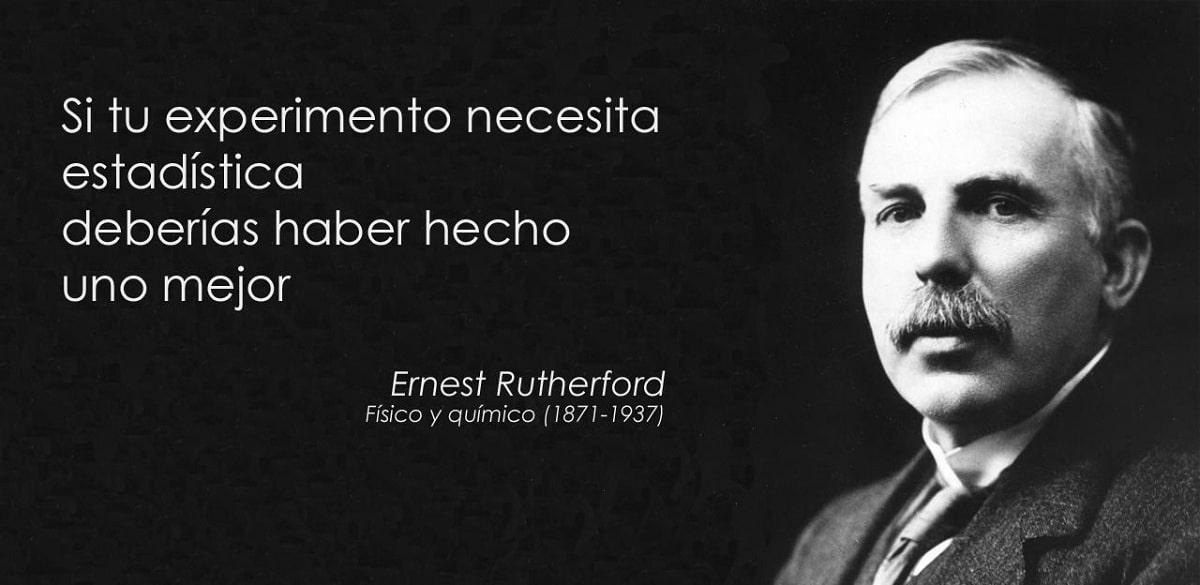
Among the scholars who contributed a great deal to science in recent centuries we have Rutherford. His full name is Lord Ernest Rutherford and he was born on August 30, 1871. He was a British physicist and chemist who contributed a lot to the world of science. He was born in Nelson, New Zealand. One of his most important contributions to science is Rutherford's atomic model.
In this article we are going to tell you everything you need to know about Rutherford's life and biography.
Rutherford biography

He was the son of Martha Thompson and James Rutherford. The father was a Scottish farmer and mechanic and his mother an English teacher. He was the fourth of eleven siblings and his parents always wanted to give their children the best education. At school the teacher cheered a lot by turning out to be a brilliant student. This allowed Ernest I could get into Nelson college. It is a college with a greater cache for many talented people. He was able to develop great qualities for rugby that made him very popular at his school.
In his final year he ranked first in all subjects and was able to enter Canterbury college. Later in the university he participated in different scientific and reflection clubs but did not neglect his rugby practices. Years later he deepened his studies of mathematics thanks to a scholarship obtained at the University of New Zealand. Later he stood out for his curiosity and his ability to solve various chemical and arithmetic problems. Therefore, he could be a great student at Cambridge.
First investigations

Rutherford's early investigations began to show that iron could be magnetized by means of high frequencies. His excellent academic results allowed him to continue with the different studies and investigations for years. At Cambridge Cavendish Laboratories was able to carry out his practices under the direction of the discoverer of the electron Joseph John Thompson. The practices began to be carried out from the year 1895.
Before leaving to undertake the adventure of the investigations, he got engaged to Mary Newton. Several years later and thanks to his work he was appointed professor at McGill University in Montreal. This was in Canada. Years later it is upon his return to the United Kingdom that he joined a teaching staff at the University of Manchester. It is here that he began teaching experimental physics classes. In the end Thompson stepped down as director of the Cavendish laboratory at Cambridge University and Rutherford replaced him.
One of the most outstanding phrases of this scientist is the following:
"If your experiment needs statistics, a better experiment would have been necessary." Ernest Rutherford
Rutherford discoveries

In 1896 radioactivity had already been discovered and this finding made a great impression on this scientist. For this reason, he began to investigate and carry out research by passing time and trying to identify the main components of radiation. He indicated that alpha particles are helium nuclei and surprised everyone in science with the formulation of the theory of atomic structure. That's where Rutherford's atomic model comes from. As a reward, he was elected a member of the Royal Society in 1903 and later president.
This atomic model was described in 1911 and later polished by Niels bohr. Let's see what are the main guidelines of Rutherford's atomic model:
- Particles that have a positive charge inside an atom they are arranged in a very small volume if we compare it with the total volume of said atom.
- Almost all the mass that an atom has is in that small volume mentioned. This inner mass was called the nucleus.
- Electrons that have negative charges they are found rotating around the nucleus.
- The electrons are rotating at high speeds when they are around the nucleus and they do so in circular paths. These trajectories were called orbits. Later I will they are known as orbitals.
- Both those electrons that were negatively charged and the nucleus of the positively charged atom itself are always held together thanks to the electrostatic attractive force.
All this was demonstrated experimentally and allowed to establish a dimension order for the real extensions of the atomic nucleus. Ernest formulated the theory about natural radioactivity that was related to the spontaneous transformations of the elements. If he lived as a collaborator in the radiation counter thanks to his work in the field of atomic physics. Thus, he is revered as one of the fathers of this discipline.
Nobel Prize in Chemistry
The contributions in science were very helpful in the First World War. And it is possible to carry out various studies for the detection of submarines through the use of sound waves. This was the first precursor of the studies, although once the dispute was over, the first artificial transmutation of chemical elements was carried out by bombarding a nitrogen atom as alpha particles. All of Rutherford's major works are still consulted today in libraries and universities around the world. Most of his works they are related to radioactivity and radiation from radioactive substances.
Thanks to the knowledge acquired in his investigations regarding the disintegration of the elements, he was able to obtain the Nobel Prize in chemistry in 1908, before publishing his atomic model. Element 104 of the periodic table was named Rutherfordium in his honor. However, we know that nothing is eternal and, although this scientist gave a great advance to science, he died on October 19, 1937 in Cambridge, England. His mortal remains were interred in Westminster Abbey and there they rest alongside those of Sir Isaac Newton and Lord Kelvin.
As you can see, there are numerous scientists who have contributed numerous experiences and knowledge to the world of science and, together, they are making us know more and more. I hope that with this information you can learn more about the biography and feats of Lord Ernest Rutherford.